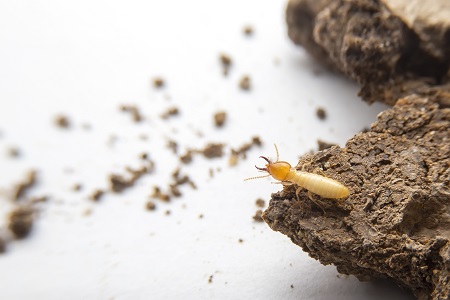Why the Bay Area Is a Termite Hotspot: 8 Reasons Your Home Is at Risk
- Jul 28, 2025
 Termites are the kind of guests who never bother to knock and eventually take over your house. They don’t leave obvious footprints; instead, they eat your home from the inside out. But what makes them so dangerous? They are silent, relentless, and almost invisible. You might not notice their presence until it is too late.
Termites are the kind of guests who never bother to knock and eventually take over your house. They don’t leave obvious footprints; instead, they eat your home from the inside out. But what makes them so dangerous? They are silent, relentless, and almost invisible. You might not notice their presence until it is too late.
Why Is the Bay Area a Termite Hotspot?
Termites are present in all the U.S. states except Alaska. Some areas suffer more while others have mild infestations. Bay Area, unfortunately, seems to be a favourite for termites, so let’s explore the reasons.
1. Mild, Moist Climate
Termites don’t do extremes – be it heat or cold. Warm, humid environments are their prime preference. The Bay Area’s unique mix of ocean moisture, cool summers, and rainy winters makes it a dream destination. Here’s why:
- Marine Layer Fog: Common in San Francisco and other coastal regions, the fog keeps the wood damp, making it suitable for subterranean and drywood termites.
- Rainy Winters: Persistent moisture in basements and crawl spaces makes it easier for the subterranean termites to nest.
- Cool Summers: Mild heat allows year-round activity since termites don’t hibernate.
2. Wood-Framed Homes and Older Construction Styles
From charming Victorian homes in San Francisco to Craftsman-style homes in Berkeley and Oakland, the Bay Area is known for its beautiful wooden homes. These types of historical homes often have:
- Exposed wooden beams
- Plaster-over-wood walls
- Decorative trim
- Attics
- Crawlspaces
- Basements
- Untreated wood
All these are also favourites for termites, thus making these older-style homes an easy target. Even newer homes have wood as the primary construction material. Unless termite-resistant wood is used, newer homes can also be affected by termites.
3. Aging Infrastructure
Old homes have an aesthetic but come with their own problems. The outdated plumbing system, along with the aging pipes, often results in hidden leaks inside walls and under floors. This can result in persistent dampness in crawl spaces, which can later lead to wood rot. Rotting wood is a termite paradise.
4. Lush Landscaping and Mulch Use
Bay Area homeowners love their gardens. While it’s great for curb appeal, it is also a termite magnet.
- Mulch beds and wood chips have cellulose in abundance (termites’ favourite meal) and also retain moisture.
- Dense vegetation close to the structure will trap moisture near the foundation.
- Overhanging tree branches and shrubs act as natural bridges for drywood termites to get into your home.
5. Earthquake Repairs
Due to California’s earthquake history, most of the homes in the Bay Area have undergone seismic repairs, which often involve:
- Reinforcing walls and foundation with new wooden beams or braces.
- Adding wood supports to crawlspaces or basements.
Fresh wood, especially when untreated, becomes extra attractive to termites since it is soft and high in cellulose.
6. Foundation Types That Encourage Termite Activity
Homes built on raised platforms are a common sight in the Bay Area, especially in cities like San Jose, Palo Alto, and Oakland. These foundations create dark and damp crawl spaces that are ideal for subterranean termite colonies. These spaces are hidden, thus giving the termites a place to multiply undetected. Homes that have pier-and-beam or slab foundations have a risk of termites slipping through the cracks in the foundation.
7. Limited Natural Predators in Urban Areas
Termite predators like ants, nematodes, and birds are common in rural settings. But in urban and suburban neighbourhoods like those in the Bay Area, these natural predators are less common, thus allowing the termite colonies to thrive with little resistance.
8. High Property Density
In tightly packed neighbourhoods and apartment complexes like those in the Bay Area, termites easily migrate from one building to the next. The spreading speed is fast due to shared walls and fences. The worst part is that the infestation can go undetected since the source of the problem might be in the neighbour’s house.
HiTech Termite Control
Protect your Bay Area home from termite damage with expert inspections and eco-friendly treatments. Hi Tech Termite Control provides reliable child and pet-safe termite treatment options in the Bay Area. Click here to get your free quote for termite inspections.
Bay Area Termite Problems – Frequently Asked Questions
1. Why is the Bay Area more prone to termite infestations?
The Bay Area’s moist climate, foggy conditions, and older wood-framed homes create an ideal environment for termites, especially subterranean and drywood species.
2. What types of termites are most common in the Bay Area?
Subterranean termites and drywood termites are the most prevalent in the Bay Area. Subterranean termites build mud tunnels, while drywood termites live inside the wood they eat.
3. How can I tell if my home has a termite problem?
Look for mud tubes, wood that sounds hollow, discarded wings, or piles of sawdust-like droppings (frass). Bubbling paint or jammed doors and windows are also signs.
4. Can termites spread from one house to another in Bay Area neighborhoods?
Yes. In dense neighborhoods with shared walls and fences, termites can easily migrate from one property to the next if left untreated.
5. Do landscaping habits increase termite risks?
Yes. Mulch, wood chips, and overgrown vegetation hold moisture and provide food, attracting termites closer to your home's foundation.
6. How often should Bay Area homeowners schedule termite inspections?
It’s recommended to get a professional termite inspection at least once a year due to the high risk of infestation in the region.





